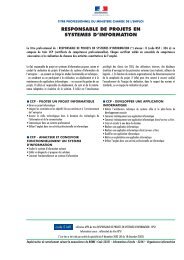Design Patterns
Download - Assembla
Download - Assembla
- No tags were found...
Create successful ePaper yourself
Turn your PDF publications into a flip-book with our unique Google optimized e-Paper software.
CHAPTER 8<br />
■ ■ ■<br />
The Bridge Pattern<br />
In the world of API implementations, bridges are incredibly useful. In fact, they’re probably<br />
one of the most underused patterns. Of all patterns, this is the simplest to start putting into<br />
practice immediately. If you’re building a JavaScript API, this pattern can be used to ensure<br />
that the dependent classes and objects are coupled to it loosely. As defined by the Gang of<br />
Four, a bridge should “decouple an abstraction from its implementation so that the two can<br />
vary independently.” Bridges are very beneficial when it comes to event-driven programming,<br />
which is a style that is used often in JavaScript.<br />
If you’re just entering the world of JavaScript API development, you’re most likely going to<br />
be creating a lot of getters, setters, requesters, and other action-based methods. Whether<br />
they’re used to create a web service API or simple accessor and mutator methods, bridges<br />
will help you keep your API code clean come implementation time.<br />
Example: Event Listeners<br />
One of the most practical and frequent use cases for a bridge is event listener callbacks. Let’s<br />
say, for instance, that you have an API function called getBeerById, which returns data about<br />
a beer based on an identifier. Naturally, in any web application, you want this data to be fetched<br />
when a user performs an action (such as clicking an element). Most likely the element you click<br />
contains the beer identifier, either stored in the element ID itself, or in some other custom<br />
attribute. Here’s one way of doing it:<br />
addEvent(element, 'click', getBeerById);<br />
function getBeerById(e) {<br />
var id = this.id;<br />
asyncRequest('GET', 'beer.uri?id=' + id, function(resp) {<br />
// Callback response.<br />
console.log('Requested Beer: ' + resp.responseText);<br />
});<br />
}<br />
As you can see, this is an API that only works if it is run within the context of a browser.<br />
Naturally, due to the way event listener callbacks work, you get passed back an event object as<br />
the first argument. That’s useless in this case, and there is only the scope of callback to work<br />
with to grab that ID from the this object. Good luck running this against a unit test, or better<br />
109











